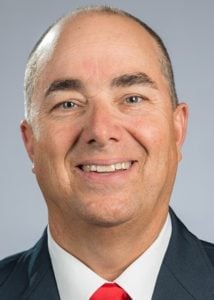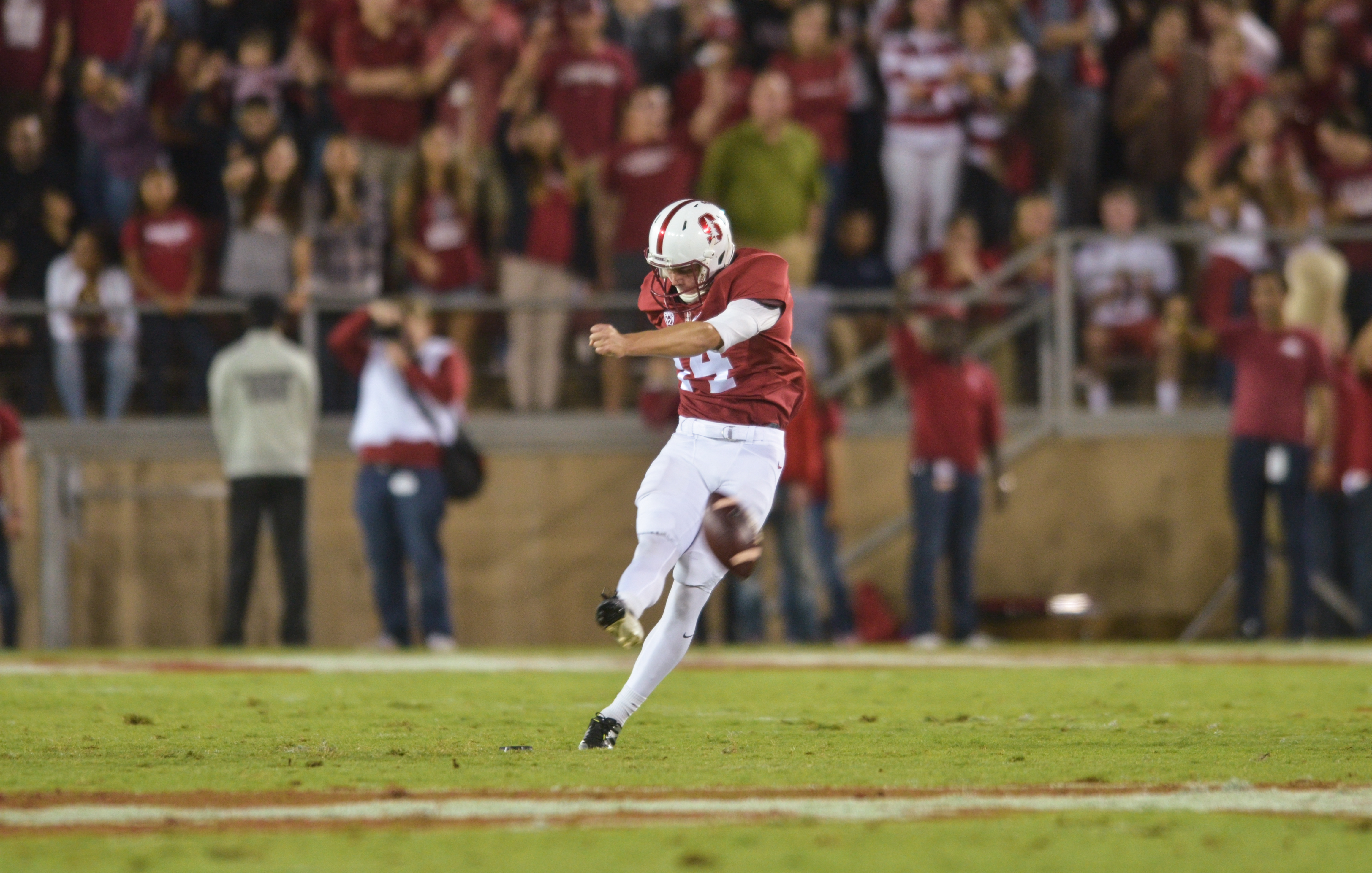It’s taken a diverse set of groups to vault Stanford into three of the past four Rose Bowls: the Tunnel Workers Union, the monster tight ends, the backfield partiers and, very quietly, the realtors.
With dominant kickoff and kick return units, in addition to an improving punt team that showed off some stellar boots from the leg of sophomore Jake Bailey against Kansas State on Friday, Stanford is in the business of “real estate acquisition,” as special teams coordinator Pete Alamar has dubbed it. It’s fair to say business has been booming.
In the last three years, Alamar’s real estate agents have included two Jet Award (given to the best returner in college football) winners in Ty Montgomery and Christian McCaffrey, as well as a Heisman Trophy runner-up in McCaffrey. The result: some of the most explosive plays in the country in the often-overlooked third phase of the game. For example, after a long punt that seemed destined to pin back the Cardinal against their own end zone in Friday’s game, McCaffrey bounced off multiple defenders inside the Stanford 5 before taking it to the house for a 97-yard return that, though later nullified by a block in the back, was featured in many a highlight reel from the night.
But Alamar, the wizard who engineered the best unit in the conference last season, might only be in that role by chance.

Originally from Thousands Oaks, California, Alamar didn’t grow up in the likeliest of football families — his mother hails from Cuba and his father from Ohio. Neither had a strong football background. Had it not been his football-playing friends, or the “cultural community football family” as he called it, football might not have been in the cards for Alamar.
But that’s not the most surprising thing about Alamar’s journey to become special teams coordinator on The Farm. After playing offensive line at Cal Lutheran University, his path to the job was pure serendipity.
During his first graduate assistant job at Cal Poly, no one was coaching the punter. Head coach Jim Sanderson told a starry-eyed, 22 year-old Alamar, “You got the punter.” He obliged, and the rest is history.
Alamar began dutifully studying up on everything about the craft. It was the start of a “long [coaching] journey” that stretched a head coaching job at Universidad Autonoma de Nuevo Leon in Mexico to coaching special teams and tight ends at Cal. Since 1983, Alamar has worked 16 different roles for 10 programs, but has always held an affinity for special teams.
“I coached on special teams wherever I could,” Alamar said, beaming. “[W]hen the opportunity came to coordinate special teams … I jumped at the opportunity to get into a leadership role in a part of the game that I really love.”
After several stints at smaller schools, Alamar’s first break came in 1993, when he became a graduate assistant under long-time coach Dick Tomey. Though Alamar left for a year to coach in Mexico, he was named the tight ends coach upon his return, and the next year, special teams coordinator. There, under the guidance of Tomey, he really began to understand how important the kicking game is in determining momentum and offensive success.
The affable, animated Alamar brought that knowledge to Stanford in 2012, taking over as special teams coordinator. He quickly turned around a kick-return unit that was 10th in the Pac-10 in 2010 and fifth in 2011. Since then, the unit has been consistently excellent, finishing third in 2012, first in 2013, fourth in 2014 and first in 2015.
Much like Stanford’s power run offense, Alamar’s units employ the power return, utilizing double teams and kick outs to form a physical, smash-mouth return group.
However, Alamar didn’t have to make drastic changes to achieve that end — he stressed the importance of fundamentals.
His return practices in spring and fall camp are broken into parts — not 11 on 11 — so he can let each group work individually. Once they’re all ready, he assembles the groups into a full unit to help them coalesce.
“We start with fundamentals,” Alamar said. “You try to set your return to the strengths of what you’ve got and what a returner does well … We build a great fundamental base and a lot of trust in each other, and you put the right 11 guys back there … you’ve got a chance.”
It certainly doesn’t hurt to have McCaffrey taking back those kicks. As a sophomore last season, McCaffrey broke Barry Sanders’ all-time record with 3,864 all-purpose yards, 1,200 of which came on kick returns, the second-most in the nation. Alamar was quick to downplay the impact one individual could have on a unit, but acknowledged that having McCaffrey taking back kicks motivated his teammates to work harder.
“It’s always great to have a great returner, but man I tell you what, if you don’t block those 10 cats, I don’t care how good of a returner you are,” Alamar said. “I think it helps with this: I think there’s great confidence with the group that when you have a special guy back there that’s going to do special things with the football, those guys are going to work extra hard to get him home. That’s what you try to build: that group pride … If you can get that going, you’re in a good place.”
McCaffrey inspired his fellow realtors to the best starting field position (+/-) in the Pac-12, on average starting 6.70 yards closer to the end zone than their opponents.
According to Alamar, that success as a group came from making schematic adjustments, depending on the opponents’ game-plan. For example, when McCaffrey took a kick return back 98 yards for a touchdown against Cal this season, Alamar put four tailbacks and one fullback deep. Usually, that’s the territory of tight ends, outside linebackers and fullbacks, a testament to the strength of the running back corps.
That sort of versatility became a weapon for Alamar, especially from McCaffrey. Also a strong boundary returner, McCaffrey’s talent made Alamar shift more towards a middle return scheme last season because it “gave [Christian] more freedom.” Since he had so much “space and room on his returns,” the middle scheme put McCaffrey in a position where, more often than not, he might only have to beat one man.
Because of his elusive yet physical running style, McCaffrey already creates a lot of his own freedom, from the backfield and in returns alike. So much, in fact, that Stanford head coach David Shaw said that McCaffrey was hit hard “less than five times last season.” In 14 games, for those of you at home. That trait has made McCaffrey a truly exceptional runner and returner.
“He’s so quick and so elusive, you get a hand on him, you grab him, kind of pull him down, somebody else bumps him and knocks him out of bounds and you drag him down,” Shaw said. “That’s typically how he gets tackled. That’s what happens with most really good backs — you don’t get a clean shot at them.”
That skill also has “absolutely” helped with McCaffrey’s durability, according to Shaw.
After a season in which he took 437 touches, the coaching staff had him sit out of contact plays in the Spring Game to avoid adding “mileage” to his frame, but they haven’t set a hard limit on his kick return numbers this season.
A famously hard worker, McCaffrey welcomes that role with open arms. “I love the work,” McCaffrey said. “I accept the work … I like being able to be pushed as far as I can go.”
Shaw said that they would “shave [some time] off the ends of practices” for McCaffrey because they expect him to shoulder a large amount of the work again this season, but isn’t concerned about cutting down on his returns.
“We can sprinkle other guys in there to return, but he loves to punt return and kickoff return,” Shaw said. “The day I walk in and tell him he’s not going to return a kickoff, I know he won’t say anything because he’ll do whatever we ask him to do, but he’ll feel gutshot. He’ll feel terrible. He loves it. He absolutely loves it. When you watch him kickoff return, you see the passion he has for it. I don’t worry about stuff like that. He’s a football player.”
Perhaps the coaching staff doesn’t feel compelled to limit his touches on special teams because it gives them such a sizable advantage. If you go simply by the numbers, success on kick returns correlates directly with the outcome of their season.
In 2012, 2013 and 2015, Stanford finished first in kick return yards twice and third once, and made the Rose Bowl all three times. In 2014, it slipped to fourth and the offense sputtered, sending Stanford to an 8-5 record and the Foster Farms Bowl.
Alamar said that many factors went into the offensive collapse that year, but acknowledged that they were certainly part of that downturn.
“Obviously, that was something that was important to us,” Alamar said. “We dipped a little bit and didn’t have the start of drive that we’d like to have. I think there’s a lot of things that go into it, but I think our part needed to be better to help the offense … Maybe we could have found another 3 or 4 yards. Statistically, that lets you get going. But also if you look, in the last part of the year the offense did a great job. You know, there’s a lot of factors that go in, but surely, we consider ourselves a part of it because we need to set the table and give those guys an opportunity to score points.”
After being picked by the media to win the Pac-12 for the first time ever, the pressure to acquire land for an offense with a first-year quarterback is on the Cardinal once again this season. If the first rule of real estate is understanding the market, it certainly seems Alamar has Stanford primed for another run at some valuable land in Pasadena — or perhaps beyond.
Contact Ben Leonard at bentleonard18 ‘at’ gmail.com.
